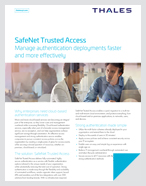Healthcare data protection
From medical records to insurance forms to prescription services, the healthcare business is a networked environment – allowing patient information to be shared and managed by a variety of parties and from a number of endpoints, each with their own level of security for protecting that information.
Thales offers comprehensive data protection and access management healthcare security solutions that protect data across devices, processes and platforms on premises and in the cloud. Our flexible healthcare data security solutions strengthen organisational security and compliance postures and securely support users’ demands for access to patient data.
- Challenges
- Solutions
- Benefits
Compliant protection of structured and unstructured data
Healthcare institutions typically store and process multiple kinds of healthcare data, ranging from images and emails to medical records and payment information. This healthcare data, much of which is subject to HIPAA compliance or other privacy mandates, is stored on multiple devices, runs on multiple operating systems and is accessed by multiple users in multiple places.
Users who need immediate, reliable access to data
Given the often urgent nature of the healthcare environment, users require immediate access to healthcare data across a range of devices and applications. IT security managers are tasked with ensuring that clinicians, researchers and patients themselves can access medical records, with no degradation in system performance.
Expanding threat landscape
According to Reuters, medical records are worth 10 times the value of a stolen credit card number. As attackers increase their sophistication, healthcare organisations must bolster their healthcare data security and compliance efforts. The unprecedented sharing of healthcare data across clinical applications, devices and facilities expands the potential surface attack area – and the security manager's challenges.
Healthcare data encryption
Encryption and key management solutions from Thales provide healthcare institutions with a single extensible framework for protecting both structured and unstructured healthcare data under the diverse requirements of healthcare institutions, across the broadest range of OS platforms, databases, cloud environments and big data implementations. Rendering patient data unusable to attackers improves your compliance with data privacy mandates.
No degradation of system performance
Our customers typically report no perceptible performance impact and the Live Data Transformation option for CipherTrust Transparent Encryption delivers industry-leading availability, resiliency and efficiency. With this option, a database or file system can be used normally, including powerful access control and logging capabilities, while it is undergoing encryption.
Strong user access controls
Thales provides healthcare institutions with the comprehensive, robust and granular controls they need to guard against the abuse of privileged user access. Through the CipherTrust Data Security Platform centralised policy and key management, customers can address security policies and compliance mandates across databases, files and big data nodes. And Thales can help you create high-assurance systems to authenticate employees using internal systems and a variety of connected devices accessing the network.
Protect organisational reputation and revenues
Data breaches at healthcare organisations have increased operating costs and impacted executive careers from IT to the C-suite, but perhaps the greatest damage is to the long-term reputation (and long-term revenue potential) of the breached organisation. Establishing a strong security and compliance posture helps defend the healthcare enterprise against negative reputational and financial impact.
Improve compliance with HIPAA-HITECH, PCI DSS and more
Data privacy mandates specify that organisations that store and process patient data – and other personally identifiable information – must protect it against theft or other loss. The CipherTrust Data Security Platform from Thales helps organisations meet HIPAA Security Rule and HITECH compliance requirements transparently – without changes to operational processes and the daily work of healthcare professionals.
Render patient records unusable to attackers
Attackers are motivated by the black market value of patient medical records. However, with Thales's data encryption solutions in place, attackers will find only a jumble of ciphertext in place of patient data.


